
Advances in Natural Sciences, Vol. 7, No. 1 & 2 (2006) (121– 129)
Biology
CONSERVATION OF GENETIC DIVERSITY OF
THREATENED CYCADS (CYCADACEAE) IN VIETNAM
Nguyen Minh Tam
Institute of Ecology and Biological Resources, VAST
18 Hoang Quoc Viet, Cau Giay, Hanoi, Vietnam
Abstract. Cycads occur in lowland forests and are threatened by their degradation, fragmenta-
tion and over-exploitation. Our results indicate that cycad population sizes were very small (less
100 individuals) with high propagules. These increased mating between closely related individ-
uals growing in clumps. The allozyme data show although all studied cycads maintained high
levels of genetic diversity, an average of 0.556 (0.491 in C. hoabinhensis to 0.598 in C. chevalieri),
the degree of inbreeding was high. Factors that contribute to the high levels of genetic variability
include dioecy, perennial and complex habitat structure. The priorities for cycad conservation is
discussed as well.
1. INTRODUCTION
Cycad habitats are threatened in two major ways, by the clearing of land for cul-
tivation and settlements and by over-exploitation. Their habitats have suffered severe
reduction and degradation. Many cycads are known to occur as fragmentary populations.
The remaining fragments are usually small in size; hence a small number of individu-
als comprised each fragment. Due to fluctuations in the number of individuals through
random demographic and environmental forces, such small populations face an increased
probability of extinction. Recolonization of fragments in which the species has become
extinct may occur if migration between fragments is still possible. However, when the dis-
tances between the remaining fragments are great, subpopulations may become isolated
from each other with a change of gene flow between subpopulations and the probability
of the species being greatly reduced. Moreover, because of their attractive leaves; most
species are collected for cultivation in collector’s gardens or to sell in local markets as
ornamental plants.
In order to conserve threatened cycads, effective conservation not only maintains
their habitats to manage their population dynamics, but also conserve the genetic diversity
that provide the raw material for adaptive responses to environmental change. The goals
of this study are to use electrophoresis and field measurements to determine the level and
structure of genetic variation, population characteristics related to heterozygosity and
genetic consequences under disturbed habitats. This study also aims to determine the
ecological factors and set up priorities for genetic conservation of cycads in Vietnam.

122 Nguyen Minh Tam
Fig. 1.Map showing the studying sites: DNC: Nam Chang, DBC: Ban Chu,
DBE: Ben En, DCP: Cuc Phuong, DTY: Thuy Uy, FDT: Deo Tra, FBM: Ba Min,
FLT: Lan Ti, FGK: Goc Khe, FCK: Cai Kinh, FLH: Lang Hang, FQS: Quang
Son, HDT and BDT: Dong Tam, HBS and BBS: Ba Sao, BPT: Phu Thanh, BCP:
Yen Quang, BTD: Tan Dan, BYT: Yen Tu, SDR: Dackrong, STH: Tan Hop, STT:
Tan Thanh, CSK: Son Kim, CNS: Nuoc Sot, and CKN: Khe Nam.
2. MATERIALS AND METHODS
518 leaf samples of 6 threatened cycads, Cycas dolichophylla, C. ferruginea, C.
hoabinhensis, C.balansae, C. chevalieri and C. simplicipinna had been collected from
November 2001 to May 2003 in 26 studied sites of 10 provinces: in Ninh Binh: Cuc Phuong
(20o21N-105o36E, 492m alt.), Thanh Hoa: Ben En (19o33N-105o29E, 110m alt.), Tuyen
Quang: Nam Chang (22o22N-105o27E, 380m alt.), Ban Chu (22o21N-105o27E, 570m alt.)
and Thuy Uy (21o44N- 105o21E, 664 m alt.) for C.dolichophylla; Lang Son: Deo Tra
(21o36N-106o20E, 373m alt.), Ba Min (21o42N-106o23E, 476m alt.), Lan Ti (21o37N-
106o24E, 311m alt.), Lang Chua (21o43 N-106o22E, 306m alt.), Goc Khe (21o45N-106o22E,
460m alt.), Cai Kinh (21o34N-106o27E, 420m alt.). Thai Nguyen: Lang Hang (21o45 N
- 106o01E, 333m alt.), Quang Son (21o44N - 105o54 E, 331m alt.) for C. ferruginea;
Hoa Binh: Dong Tam (20o14N-105o50E, 360m alt.), Ha Nam: Ba Sao (20o30N-105o56E,
334m alt.) for C. hoabinhensis; Hoa Binh: Phu Thanh (20o16N-105o51E, 158m alt.) and
Dong Tam (236m alt.), Ha Nam: Ba Sao (246m alt.), Ninh Binh: Yen Quang (20o21N –
105o36E, 365m alt.), Quang Ninh: Tan Dan (21o08 N-106o52 E, 50m alt.) for C. balansae;
Ha Tinh: Son Kim (18o26N-105o15 E, 212m alt.), Nuoc Sot (18o28’12N-105o18’23 E, 358m
alt.) and Khe Nam (18o32’54N-105o21’09E, 547m alt.) for C. chevalieri ; and Quang

Conservation of Genetic Diversity of Threatened Cycads (Cycadaceae) in Vietnam 123
Tri: Dackrong (16o40’00N-106o52’14E, 387m alt.), Tan Thanh (16o36’15N-106o38’23E,
281m alt.) and Tan Hop (16o39’21N-106o44’32E, 481m alt.) for C.simplicipinna (Fig.
1). Samples were immediately kept in the icebox. They were transferred to the Lab.
Molecular Biology, Institute of Ecology and Biological Resources and subsequently stored
at -80oC until used enzyme electrophoresis. Parameters of population size, habitats and
interviews were determined and implemented in the field.
Polyacrylamide gel electrophoresis was used to obtain allozyme data. Leaf tissue
was ground in 1 ml extraction buffer of Triest (1989). The electrode buffer was Tris-CI and
Glycine. The gels contained two parts, stacking gel with 0.5M Tris-CI, pH 6.8 and 4.5%
acrylamide, and running gel with 1.5M Tris-CI, pH 8.8 and 10% acrylamide. Gels were
run for 3 hours at 70 mA and 4˚C and then stained at room temperature for 12 enzymes:
Shikimate dehydrogenase (SKDH), Aspartate aminotransferase (GOT), 6-P-Gluconate de-
hydrogenase (6PGDH), Isocitrate dehydrogenase (IDH), Leucine aminopeptidase (LAP),
β-esterase (β-EST), Esterase (EST), Alcohol dehydrogenase (ADH), Malate dehydroge-
nase (MDH), Xanthine dehydrogenase (XPH), Acid phosphate (APH) and Malic enzyme
(ME). Six enzymes resulted clearly consist of GOT, LAP, SKDH, 6PGDH, IDH and β-
EST and were used to assess genetic variability, using the FSTAT and TFPGA programs
(Goudet, 1995; Miller, 1997)
3. RESULTS
Hill et al. (2004) identified areas for six species, of these, four Cycas dolichophylla,
C. ferruginea,C.hoabinhensis and C. balansae in North Vietnam and two remaining
species, C. simplicipinna and C.chevalieri in central Vietnam. C. dolichophylla occurs
in shade of lowland rainforests, on loamy soils over limestone, schist or granites. This
species was recorded in the little disturbed forest of Nam Chang, Ben En and Cuc Phuong.
Habitat structure is complex and includes three distinct strata. The canopy of tall trees,
up to 35-40m in height, with wet and warm summer; and dry and cool winter. The
understorey is made up of young trees of the canopy and shrubs. Ban Chu and Thuy Uy
were heavily suffered by commercial logging and destroyed for cultivation. C. ferruginea
and C. hoabinhensis occur in shrub forests, on bare limestone faces on steep bluffs. They
were found in completely destroyed forests on steep or ridge of limestone hills at Lang
Chua, Cay Khe, Lang Hang, Cai Kinh, Quang Son or Dong Tam and Ba Sao or disturbed
forests at Deo Tra and Lan Ti. C. balansae was found in shade in pine plantations at Tan
Dan and valleys, on sandy loamy soils over schist or granites at Ba Sao, Phu Thanh and
Dong Tam. Due to the distribution at low and medium elevation, its habitats had been
greatly fragmented by human activities. At present, over-exploitation of fuel wood is a
major cause for degraded habitats and creates growth of a light-demanding species. C.
chevalieri was found in shade in illegal logged lowland forests at Khe Nam and regenerating
secondary forests along Rao An river at Son Kim. .Three species, C. dolichophylla,C.
balansae and C. chevalieri prefer high humidity, with low temperature in winter and high
temperature in summer. C. simplicipinna occurs on sandy loams over schists in boulder
beds along river bank of Rao Quan, in greatly disturbed forests. This was also found in

124 Nguyen Minh Tam
shrubs along river bank of Dackrong and arable land at Tan Thanh. The geographical
distribution of the cycads is greatly influenced by human activities. Their distribution is
highly fragmented. All studied populations are known to be very small for their survival
in nature. The population size varied from 3 individuals at Ban Chu, the buffer zone
of the Na Hang Nature Reserve to 37 at Cuc Phuong, an average of 25 individuals per
C. dolichophylla population. Similarly for C. ferruginea populations varied from 28 at
Lan Ti to 75 at Cai Kinh, averaged 47 individuals. Population size averaged 31.5 for
C. hoabinhensis, 58.8 (25 at Ba Sao-87 at Yen Quang) for C. balansae, 28.7 (23 at Tan
Thanh-41 at Tan Hop) for C.simplicipinna and 26.7 (23 at Son Kim-33 at Khe Nam) for
C. chevalieri. Cycads in each population grow scatterly or the form of small clumps on
determined faces of the hills. Most cycads of C. ferruginea and C.hoabinhensis grow on
flanks of limestone hills in East-south. For this reason, these flanks receive light abundant
favorable environment, while cycads in remaining species grown in shade of overstorey and
understorey.
Demographic data from all studied populations showed the number of propagules
produced by females in a population varied. This depended on environmental conditions
and their habitats. Low proportion of propagules was determined at Lang Hang (34.21%)
for C. ferruginea, Ba Sao (35%) for C. balansae, Tan Hop (27.5%) for C. simplicipinna and
Khe Nam (21.9%) for C. chevalieri. Higher values were found for remaining populations.
The highest proportions were recorded at Tan Thanh (95.8%), Dong Tam (80%) and Cuc
Phuong (70.27%) for C. simplicipinna, C. hoabinhensis and C. dolichophylla, respectively.
These differences may be relative to age structure within populations. It was difficult
to discriminate male and female for young individuals, even mature ones. A number of
males and females observed for each population were very small. Three females of C.
balansae produced seeds were recorded at Yen Quang and Dong Tam. However, sex ratio
(female/male) was also determined at some populations of C.simplicipinna. This value
was 12.5% at Tan Hop. Due to human impact on their habitats and over-exploitation,
these influenced greatly population structure. Only one male was observed at Tan Thanh,
Dackrong and Son Kim. Asexual propagules produced from cut parent individuals were
high, an average of 6.7 per parent at Tan Hop. Three propagules were produced from one
parent individuals at Dackrong. Asexual propagules were observed at Cuc Phuong, Na
Hang and Nuoc Sot. Clearly, this will affect greatly on mating system within populations.
Six enzyme systems provided 10 interpretable loci for 88 individuals from 4 pop-
ulations of Cycas dolichophylla, 80 from 3 populations of C. chevalieri and 29 from 2
populations of C. hoabinhensis, 12 loci for 76 from 7 populations of C. ferruginea, 11 loci
for 152 from 6 populations of C. balansae and 9 loci for 86 individuals from 3 populations
of C. simplicipinna. A number of alleles was 36 for C. dolichophylla and C. chevalieri ;
43, 38, 32 and 31 for C. balansae, C. ferruginea, C. simplicipinna and C. hoabinhensis.A
mean number of alleles per locus were recorded at population and species levels. There
were differences on the number of alleles between populations. The highest value was
found at BCP population (4.45) and lowest was found at FGK population (2.4). Three
alleles were found for each locus at species levels for C. dolichophylla, C. balansae, C.

Conservation of Genetic Diversity of Threatened Cycads (Cycadaceae) in Vietnam 125
simplicipinna and C. chevalieri. Lower values were found for two remaining species, C.
ferruginea and C. hoabinhensis. High proportions of polymorphic loci were determined
at population and species levels. This proportion at 95% criterion varied from 95% for
C.ferruginea to 100% for 3 species C. dolichophylla, C. hoabinhensis and C. chevalieri.
Observed heterozygosity averaged 0.326, ranging from 0.273 at DBE to 0.433 at DBC for
C. dolichophylla; 0.321 ranging from 0.284 at FGK to 0.383 at FLT for C. ferruginea.
Similarly, these values were 0.318 (2.7 at HBS - 3.1 at HDT), 0.347 (0.283 at BDT - 0.406
at BBS), 0.393 (0.349 at STH - 0.457 at SDR) and 0.403 (0.368 at CNS – 0.426 at CKN)
for C. hoabinhensis, C. balansae, C. simplicipinna and C. chevalieri, respectively.
The monomorphic loci were found only in 2 populations of FBM and FQS for
C.ferruginea. There were on monomorphic loci to be found in all remaining studied
populations for all six species.Three loci, namely, Got-1 in BDT and BBS, Got-2 in BBS
and β-est-2 in BPT and BBS showed low levels of polymorphism, with a frequency of the
most common alleles of over 0.9 and lowest heterozygosities under HW equilibrium for
these loci, an average of 0.152, ranging from 0.08 at β-est-2 in BPT to 0.199 at Got-1
and 2 in the same population BBS. Higher levels of genetic variation were found for a
population at Got-2 in the frequencies ranging from 0.83 in BYT to 0.63 in BCP with the
heterozygosities ranging from 0.333 to 0.476, respectively. Similarly, only one locus Got-2
in STT and one Idh-2 in FQS showed low level of polymorphism, with a frequency of the
most common allele of over 0.9 and lowest heterozygosity of 0.093 and 0.089 under HW
equilibrium, respectively. Higher variation was found for all remaining loci in all studied
populations.
Data on the distribution of genotypes showed high levels of homozygotes for most
common alleles in all studied populations. These values ranged from 11.1% at Lap-1 and
2 to 74.2% at Got-2, average of 32.6% for C. chevalieri ; from 8.3% at β-est-1 to 85.1%
at Got-2, an average of 35.9% for C. simplicipinna, from 6.1% at β-est-1 to 75.6% at
β-est-2, average of 36.4% for C. balansae, from 20.3% at Lap-1 to 75.7% at Idh-2, average
of 41.7% for C. ferruginea, from 5.7% at Skdh-1 to 65.4% at Got-2, an average of 41.8%
for C. dolichophylla, from 13.7% at Lap-1 to 82.7% at Got-1, average of 45.7% for C.
hoabinhensis. At population level, these values ranged from 35.2% at BCP to 42% at
BYT and BDT (average of 39.3%) for C. balansae; from 33.5% at CKN to 38.7% at
CSK, average of 35.7% for C. chevalieri; from 32.4% at SDR to 39.4% at STH, average of
35.8% for C. simplicipinna, from 33.3% at DBC to 50.6% at DBE, average of 43.5% for
C.dolichophylla, from 38% at FDT to 52% at FBM, average of 46.2% for C. ferruginea,
and from 46.1% at HDT to 50.3% at HBS, average of 48.2% for C.hoabinhensis.
The mean fixation values were also found at each locus and indicated a great deficit
of heterozygotes compared to HW equilibrium. The coefficient of excesses of homozygotes
or heterozygotes compared with panmictic expectations within populations for all popu-
lations of 0.343 (0.218 at SDR to 0.404 at STH), 0.306 (0.281 at CKN to 0.401 at CNS),
0.377 (0.357 at HBS to 0.397 at HDT), 0.386 (0.244 at BBS to 0.470 at BYT), 0.453 (0.388
at DBC to 0.49 at DBE) and 0.396 (0.253 at FLT to 0.49 at FCK) for C.simplicipinna,

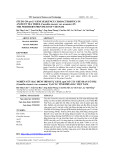
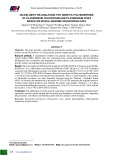


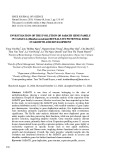
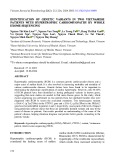

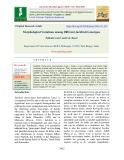

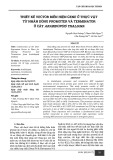



![Bài tập Đa dạng thế giới sống [kèm đáp án/ hướng dẫn giải]](https://cdn.tailieu.vn/images/document/thumbnail/2025/20251123/thaohoang9203@gmail.com/135x160/5861763951302.jpg)











